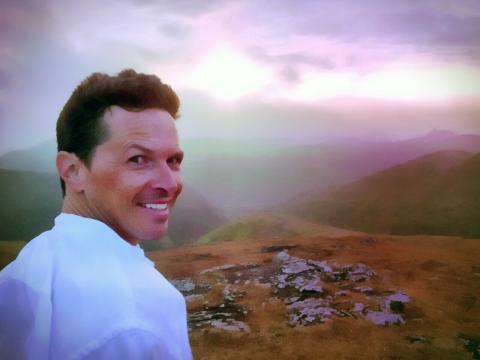Alumni Profile

Nils de Mol van Otterloo
Accidental Transformation
After graduating with his degree in music production and engineering, Nils de Mol van Otterloo felt ready to take on the music industry. So he charted his course for Los Angeles. “Like a lot of people, my plan was to go there and make it in the music business,” Van Otterloo remembers. “I was lucky to have a few connections that opened doors to work with film composers.” Things were going well for the first six months, but then changed suddenly.
“I had gone to bed on a Thursday,” Van Otterloo says, “and woke up Friday morning with a bad headache on one side of my head. I called my mother and told her about the headache, and as I talked to her, I was having trouble finding words. I later checked my e-mail and the messages looked like they were written in Klingon. I couldn’t read them. So I went to the hospital thinking they’d give me some medication that would straighten me out and I’d be able to go back to what I had been doing.”
That would not be the case. The doctors did an MRI on Van Otterloo and determined that he had a vascular anomaly called arteriovenous malformation in his brain. This abnormal tangle of veins and arteries had ruptured, blood pooled on Van Otterloo’s brain causing a type of stroke. The results are devastating for many patients. The situation was urgent, so the doctors had Van Otterloo transported to Cedars-Sinai Hospital. The surgeons there operated and corrected the problem and saved Van Otterloo’s life. He remained in the hospital for a month.
He is in the small percentage of people that survives such a brain injury and an even smaller number who recover most of their former capabilities. But as is often the case, life changes after such a trauma. “Afterwards, my whole life was different,” Van Otterloo shares. “I was not quite the same person I was before prior to the injury. I have some challenges, but there are also some areas where I am much improved. I like to tell people that I had cosmetic brain surgery. Before this incident, I could be moody and not the most fun person to be around. Afterward, I had a much better outlook on life. People who survive a life-threatening incident gain a different perspective.”
On the negative side of the ledger, Van Otterloo began to have grand mal seizures. On the positive, the medication prescribed to control his seizures also helps with mood disorders. He ended up a much happier person.
“My recovery was slow and steady,” he says. “I decided to stay in Los Angeles and took a job at Sound Art L.A. The company conducts after-school music programs and at the time, was working with youth at the Camp David Gonzalez juvenile detention center.” Van Otterloo stayed with Sound Art for 10 years and became an assistant manager for the program. The work combined his love of music and desire to help others. It got him thinking about where to go next with his career. He decided to pursue a master’s degree in music therapy, but couldn’t find a good local program.
“My wife is a social worker, a graduate of USC’s Suzanne Dworak-Peck School of Social Work,” Van Otterloo says. “So I decided to study social work. My experience working with at-risk youth was useful and I was interested in studying neurological disorders and traumatic brain injuries.” As part of his program, Van Otterloo worked in hospice care with patients suffering from dementia and began using music to help them.
“I worked with one woman who was always sleepy, not very interactive,” he states. “I pulled up the Glenn Miller band’s version “Chattanooga Choo Choo” on my phone and she started singing along. Soon, she was up and smiling and I realized that this could help other patients. I am surprised that this has not been more institutionalized than it is presently.”
One of his professors suggested that he apply for a Fulbright Fellowship to do research on musical reminiscence therapy for dementia care. “This professor was very good at planting seeds in his students’ minds,” Van Otterloo says. At first he had doubts about getting the Fulbright, but he received it and went to work among the people of India for six months. “India has the fastest growing cohort of people with dementia, but not a lot of resources for them,” Van Otterloo shares. “I searched YouTube for famous Bollywood songs from the 1950s, and was able to get the same effect I had gotten with my American patients. When I got back to USC, I began working as a research scholar in residence at the Keck School of Medicine.”
Van Otterloo also began doctoral studies at the Peck School of Social Work and currently serves as their creative arts and wellness coordinator.
The professor who advised Van Otterloo to apply for the Fulbright has encouraged him to consider a teaching career. “He’d like to see me become a professor,” he says. “People who knew me before my brain injury would laugh at this because my personality is so different from that of the average social worker. But if I can get hired as a professor, I would go for it.”
While at Berklee, Van Otterloo couldn’t have predicted a journey would take him from studio engineer to social worker to academia. While many people consciously reinvent their lives, Van Otterloo’s life was transformed literally by accident, and he’s pleased with the outcome. “I am working as a doctoral student, going off to conferences, and have never been more busy,” he says. “As well, my wife and I had our first child. I feel I am really living my life.”




